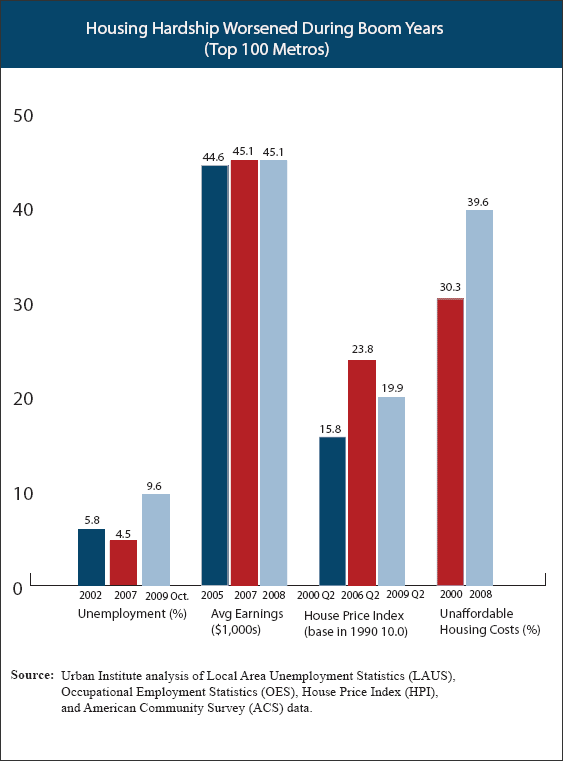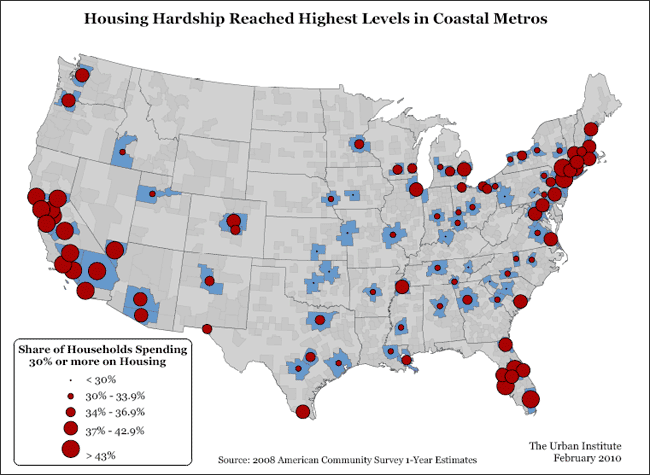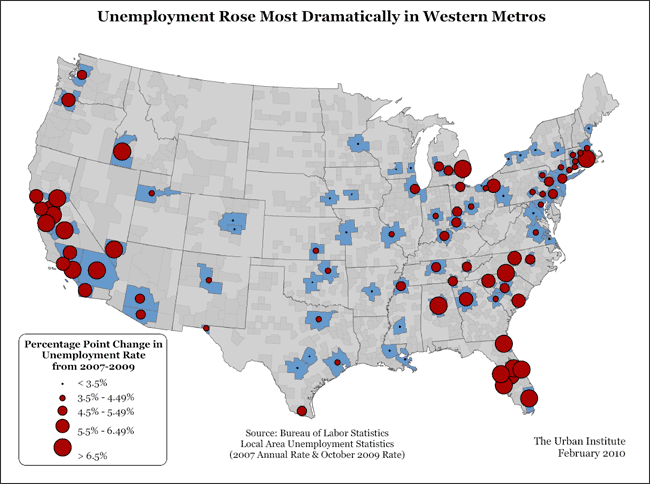
|
|
Earnings and Housing Affordability Despite the Drop in House Prices, Affordability Problems PersistDuring the boom years (roughly 2003-2007), unemployment was low in most of metropolitan America, but average earnings remained essentially flat. In the top 100 metros nationwide, average earnings grew only 1.2 percent from 2005 to 2007, after accounting for inflation. And because real rents and house prices rose precipitously over this period, housing hardship worsened. The share of households spending 30 percent or more of every month's income on rent or mortgage costs climbed from 30 percent in 2000 to 40 percent in 2008. Since the recession started, unemployment has spiked—jumping from 4.6 percent among the top 100 metros in 2007 to 9.6 percent in October of 2009. Average earnings have declined (though 2009 data aren't yet available) and house prices have plummeted. That said, average home prices remain well above their starting point—26 percent higher in 2009 than in 2000. And most families' monthly rent or mortgage payments haven't fallen because they haven't yet moved or refinanced. At least for now, housing affordability problems are more prevalent, not less. One indication of deepening hardship in the downturn is the recent rise in food insecurity. Until 2007, about 11 percent of metropolitan households experienced food insecurity. But in 2008, this share climbed to almost 15 percent. The stories behind these basic trends—and their likely future consequences—aren't all the same. In coastal metropolitan areas, average earnings are far higher than in the heartland. During the boom years, concentrations of well-educated, high-wage earners pushed housing prices beyond the reach of low- and moderate-income families. In metro Los Angeles, for example, the share of households with unaffordable housing cost burdens topped 50 percent in 2007. And in the Miami region, 53 percent of households lived in unaffordable housing. Most of these coastal metros have seen substantial job losses and house price declines—again, double trouble. But the recession hit Western metros especially hard. LA's unemployment rate jumped from 4.8 percent in 2007 to 11.8 percent in October 2009, and house prices plunged 32 percent between 2006 and September 2009. In many metro areas in the Midwest and South, average earnings remained lower and the gap between high- and low-wage workers was less pronounced than on the coasts. So even during the boom years, housing costs remained more affordable. In the Wichita metro area, for example, house prices rose by only 5.1 percent between 2000 and 2006 and the share of families paying unaffordable cost burdens reached only 26 percent. These are the metros that now seem to be weathering the downturn best. But some Midwestern metros—especially in Ohio and Michigan—never enjoyed a real boom. The Lansing metro area, for example, saw unemployment inch up between 2002 and 2007 and then more than double by August 2009. Even though house prices remained relatively low by national standards, in 2008 36 percent of families in Midwestern metros paid unaffordable housing cost burdens. Over the next 5 to 10 years, as the economy recovers and housing values stabilize, there's a reasonable chance for better alignment of housing costs and incomes, because housing markets will likely recover without immediately forming another bubble. If house values increase moderately as employment and earnings gradually return to normal, more families will find their housing costs affordable. The lowest-wage workers still won't find much housing that they can reasonably afford, but housing hardship levels could return to what they were in 2000 rather than 2007—more like Wichita's than Miami's. |
Experts Feedback
Send us your comments to help further the discussion. Share
Commentaries
|








 Harry Holzer
Harry Holzer Margery Austin Turner
Margery Austin Turner